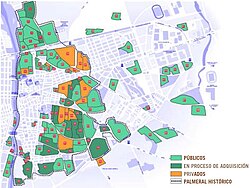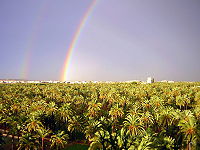Palm grove of Elche
The Palmer Grove of Elche, also known as Huertos de Palmeras de Elche (in Valencian, Horts de palmeres d'Elx), is a large expanse of palm trees within the Spanish city of Elche. Between 200,000 and 300,000 specimens, it is the largest palm grove in Europe, occupying some 500 hectares and one of the largest in the world, only surpassed by some Arab palm groves. The main species is the date palm (Phoenix dactylifera), which was brought there by the Muslims when they occupied the Iberian Peninsula.
The palm or palm is valued very well in the Spanish market and also in clandestine exports; The date industry and the manufacture of palms are very important, whose leaves are taken to a special bleaching process, depriving them of light.
El Palmeral de Elche was declared a World Heritage Site by Unesco on November 30, 2000.
Origin
Some historians unanimously place the origin of the palm tree and the pomegranate tree at the time of the Phoenicians, but the truth is that palm trees already exist in Iberian vases from Elche, as confirmed by the historian José Aparicio Pérez. An irrigation system was in place in Iberian times, prior to the Romans who adapted and expanded it, but with the arrival of the Egyptians, experts in irrigation from the Nile, who settled mainly in Valencian territory -since the Muslims, dedicated more livestock, they occupied Andalusia, they configured the palm grove in a more orderly manner.
The Palm Grove of Elche in Muslim times would be much larger than the 300,000 specimens of date palms today. There are palm trees that are 300 years old, taking into account that the palm tree takes about 10 years to develop a meter of trunk.
The first Muslims who settled in Elche followed the same protection tactic and increased the plantation; with Abderramán I the great network of ditches was made. Verses dedicated to one of the first peninsular palm trees are attributed to this Umayyad prince, exiled in al-Andalus:
Oh, palm! You are, like me, foreign
in the West, away from your homeland.
Later, in the Middle Ages, a series of laws were enacted to protect it and since then it has never stopped watching and caring.
The first precedent of interest of the authorities for the protection of the Palm Grove already took place in 1265 with the reconquest of Jaime I, who apparently prevented them from being razed because they were associated as an identifying element of Islamic culture.
Composition
The best-known complexes of the Palmeral are the Municipal Park, the Huerto de Abajo, the Huerto del Cura and the Huerto del Chocolatero. Among all, the best and oldest specimens are in the so-called Huerto del Cura, within the great Palm Grove. The name comes from its owner in 1918. Some specimens are over 300 years old. It must be taken into account that the palm tree has an average life of 250 to 300 years. These palms are of the same species as those of Iran. They are dates and it is in December when they bear fruit. In addition there are some other tropical species.
The Imperial Palm Tree
In the complex, the so-called Imperial Palm Tree stands out, which received that name in homage to the Empress Isabella of Bavaria (Sissi), who visited the Garden in 1894. This palm tree has seven enormous stems in the shape of of a chandelier and Sissi said of her that she was worthy of an Empire.
Palm Grove Route
A pleasant walk among the Elche palm orchards begins and ends at the Huerto de San Plácido, also known as the Museo del Palmeral. It is a route of little difficulty suitable for all audiences, it can be done on foot or by bicycle. It has a total distance of 2,580 meters.
Diseases
In 2005 it was detected that there were specimens of palm trees infected by red palm weevil larvae (Rhynchophorus ferrugineus). This beetle lays its eggs inside the palm tree and when the eggs hatch, the larvae feed on the stem of the plant.
Contenido relacionado
Castries
Vermellar
Nepal




